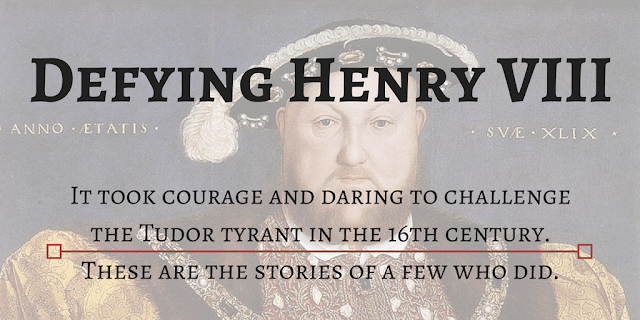Few people dared to challenge the authority of King Henry VIII of England. Of those few, most did not live long enough to regret it. Henry's vengeance burned furiously and unrelentingly. One man, who happened to be Henry's cousin, was the object of his anger for more than twenty years and was clever enough to survive.
 |
| Cardinal Reginald Pole |
Enter Anne Boleyn.
Once Henry VIII had been given the title Defender of the Faith by the Pope, but the middle aged king with an even older wife was tempted to break his marriage vows in order to satiate his lust and father a more worthy heir than the teenage daughter he already had. Reginald's faith, however, remained unshaken. Henry requested that Reginald write a defense of his plan to replace Queen Catherine with Anne, expecting that the years of friendship and support, not to mention their familial bond, would ensure Reginald's loyalty. Oh, if only he could have foreseen the drama he was unleashing throughout the Christian world.
Instead of supporting his king, Reginald wrote a fierce indictment of his plans to annul his marriage of more than twenty years. Without digging too deeply into the arguments over Henry's Great Matter, we can simply say that Reginald and Henry split, permanently and deeply. In 1526, Henry offered Reginald the Archbishopric of York to bargain for his loyalty. Reginald refused even that tempting bait.
Henry's battle to rid himself of Catherine took longer and had further reaching consequences than Henry could have imagined, but he was not a man to give in when he wanted something! He removed Reginald's mother, who was by this time Countess of Salisbury, from her position as Princess Mary's governess when Margaret too forcefully spoke up for Mary's rights. However, Henry seemed to carry on good relationships with Reginald's brothers, taking them on campaign in France and giving them positions at court. Meanwhile, Reginald remained safe in Italy.
 |
| Cappella di Reginald Pole, Rome |
This peace did not last for the Pole family. In 1539, Reginald rejected Henry's offer of the Bishopric of Salisbury, knowing that returning to England would mean his imprisonment and probable death. Angered by this and his family's continued support of Mary (and whispered rumors that they wished to see her married to Reginald) and their continued adherence to the Catholic faith, Henry persecuted what members of the Pole family he could get his hands on. In a debacle that would become known as The Exeter Conspiracy, Geoffrey Pole was imprisoned and tortured and Henry Pole was executed. Margaret, in her sixties by this time, was also arrested.
After his brother's execution, Reginald and was attainted in absentia. Henry even executed Reginald's elderly mother in 1541. No doubt remained that he could never return to his homeland.
Reginald was forced to travel separate of his fellow cardinals with a troop of 25 horseman guards when he participated in the Council of Trent in 1546. They took a secret route in order to avoid assassins. Those who lived in Viterbo, where Reginald governed as papal legate, knew to report any strangers in the area who might have been sent by the English king.
What finally allowed Reginald to move freely and eventually return to England was the death of King Henry in January 1547. During the short reign of Edward VI, Reginald exchanged letters with the Duke of Somerset and the king himself, but he was hesitant to return due to the religious reforms taking place. Of course, he also had his own work keeping him busy, which included the papal conclave of 1549-1550 that almost elected him Pope.
Reginald did finally return to England in 1554. He was not wed to Mary, now queen, as many had hoped. Instead, she made a disastrous match with Prince Philip of Spain and Reginald became Archbishop of Canterbury. Reginald died of natural causes (quite an accomplishment for a man with York blood in the Tudor era) on November 17, 1558, the exact same day as Queen Mary, ending the counter-reformation in England.
Don't miss the rest of the Defying Henry VIII series!




Very well written piece. I look forward to seeing who you share with us next.
ReplyDeleteThank you so much, Meghan! I believe I'm going to look at Richard de la Pole next. I love those sons of York!
DeleteI dont think he was really a Christian .
ReplyDeleteYou don't think Reginald Pole was really a Christian? What gives you that impression? He was one of few leaders of the era who were willing to consider and discuss reformist ideas and admit that the Catholic Church suffered from corruption.
DeleteHe didn't save the people Mary burnt. If he was a believer he would have.
DeleteThat is a very modern mindset. In the 16th century, one would not have been considered a true Christian if they did not believe in punishing heresy.
DeleteThis comment has been removed by the author.
DeleteThis comment has been removed by the author.
DeleteThis comment has been removed by the author.
DeleteBut didnt they know the Bible said thou shalt not murder?
DeleteThis comment has been removed by the author.
ReplyDelete